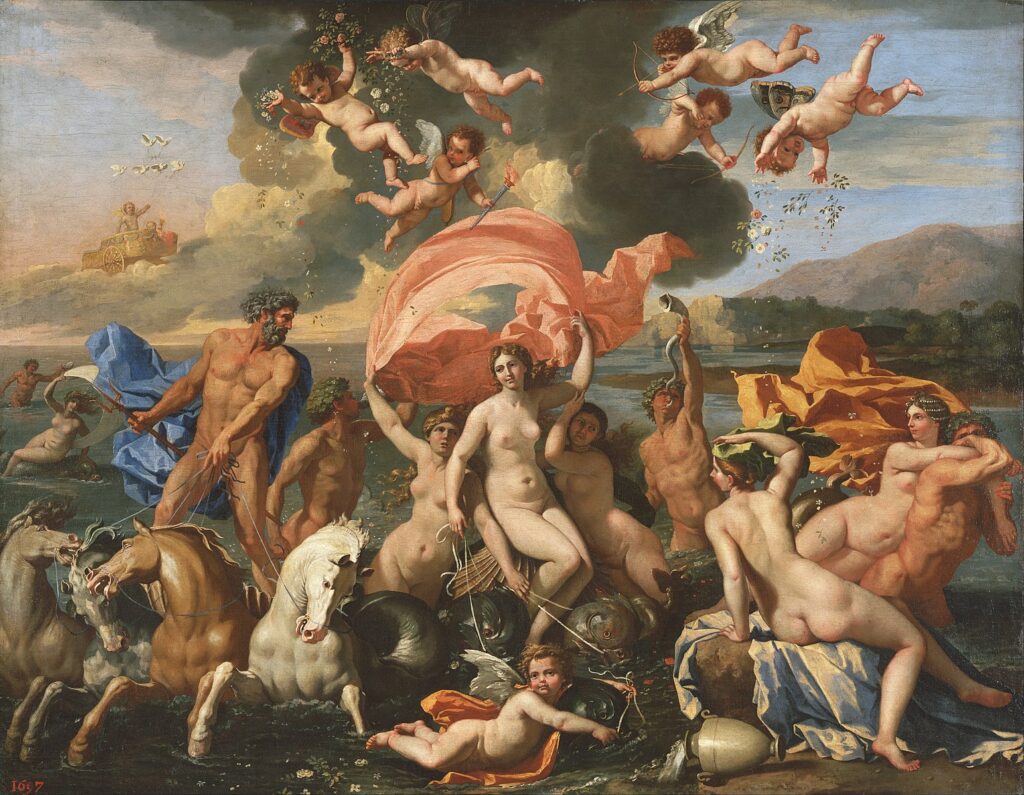Aphrodite, the goddess of love and beauty, was born of the severed genitals of the primordial sky-god Uranus when his son Cronus tossed them into the barren sea. Foam-born Aphrodite came to life among the gentle sea deities of the Aegean. Being born without a mother is not such an odd occurrence in Greek mythology. Athena sprang forth from Zeus’ brow fully-grown and fully-armed. Dionysus was born of his father Zeus’ thigh.
Hesiod sings of how Doris the daughter of Okeanos (Oceanus) bore fifty daughters [the Nereides] to Nereus the sea-god, whom to this day we always hear of as truthful and unlying. Homer also mentions them in his poems. But they do not state that one son was born after all that number of daughters, though he is celebrated in mariners’ tales. And they say that he was named Nerites.[1]

© The Trustees of the British Museum
“Nerites was the most beautiful of men and gods.”[2] He served as Poseidon’s charioteer. When they drove their “chariot over the waves, great monsters of the deep, dolphins and sons of Triton, sprang up from the deep, galloping and dancing alongside the chariot. His escort would be promptly left behind as over the smooth-spread waves coursed his steeds.” His sisters sported on the peaceful sea while he raced across the wine-dark sea driving a team of four steeds yoked together. “Aphrodite was also delighted to be with Nerites in the “(Aegean) sea and loved him”. When Zeus, the Father of the gods summoned Aphrodite to be enrolled among the Olympians, “she wished to bring her play fellow. But Nerites refused, preferring life with his sisters and parents to Olympus.”[3]
At this point Aphrodite departed her watery world and entered ours:
Her gods and men call Aphrodite, and the foam-born goddess and rich-crowned Cytherea, because she grew amid the foam, and Cytherea because she reached Cythera, and Cyprogenes because she was born in billowy Cyprus …And with her went Eros, and comely Desire followed her at her birth at the first and as she went into the assembly of the gods.[4]

There is a primordial Eros more of the abstraction of reproduction. But the younger Eros is most often considered Aphrodite’s son, but how came he to be present at his mother’s birth? That is to say, when she stepped ashore for the first time. And who was his father?
Later poets suggested many answers, including Ares, Zephyrus, Chaos and Poros. Graves suggests Hermes and Zeus. (But that’s another blog post.) Aaron J. Atsma says:
Hesiod may be suggesting that Eros and Himeros were born of Aphrodite at her birth. Indeed, according to Sappho, Ouranos was the father of Eros by Aphrodite, which suggests she was imagined born pregnant with the god. Nonnus says this explicitly.[5]
There is no myth associating Ares and Aphrodite prior to her ascension to Olympus. The only myth about Zephyrus and her is at the moment of her departure from the sea. Poros is more of a philosophical abstract. Rather than the double monogenesis formed by the Ouranos option, I’d prefer to use Occam’s Razor to finish off the hydra-headed question of Eros’ paternity and suggest simply Aphrodite’s foster brother Nerites.
As noted above the goddess and the handsome godling were lovers. And “the embraces of the gods are not fruitless. [6] Hence, Nerites is the father of Eros “the god of sensual love, who bears sway over the inhabitants of Olympus as well as over men and all living creatures: he tames lions and tigers, breaks the thunderbolts of Zeus, deprives Heracles of his arms, and carries on his sport with the monsters of the sea.” [7]
Developed from version originally published at Bill’s Greek Mythology.
Related posts
Gallery: The Birth of Aphrodite
Notes
[1] Aelian, On Animals 14.28. Translated by A.F.Scholfield (1958), with some minor alterations.
Online at Attalus.org
[2] “Nerites,” in William Smith, Dictionary of Greek and Roman Biography and Mythology, Little, Brown, and Company, 1876.
Online at archive.org
[3] Aelian, On Animals 14.28.
[4] Hesiod, Theogony 196–203. Translation by Hugh G. Evelyn-White.
Online at Perseus
[6] Homeric Odyssey 11.249–250. Translated by Samuel Butler. Revised by Soo-Young Kim, Kelly McCray, Gregory Nagy, and Timothy Power.
Online at Kosmos Society
[7] “Eros,” in William Smith, Dictionary of Greek and Roman Biography and Mythology, Little, Brown, and Company, 1876.
Image credits
John Flaxman: Sea Divinities, Nereus and Doris with their daughters the Nereids and sons [sic] the Nerites, illustration for Hesiod’s Works and Days and Theogony, c. 1815.
Creative Commons Attribution-NonCommercial-ShareAlike 4.0 International (CC BY-NC-SA 4.0) license.
© The Trustees of the British Museum
Nicolas Poussin: The Birth of Venus, 1635 or 1636. Philadelphia Museum of Art E1932-1-1.
Public domain, via Wikimedia Commons.
___
Bill Moulton is a member of Kosmos Society.